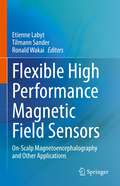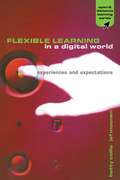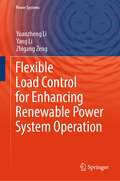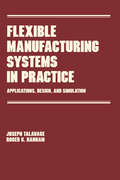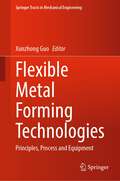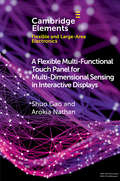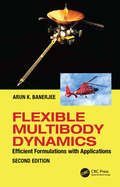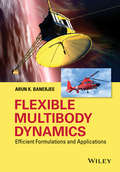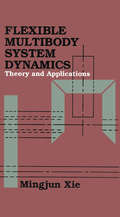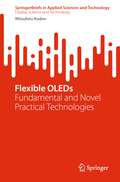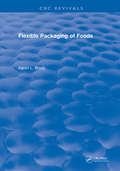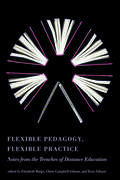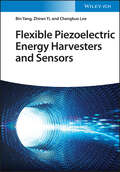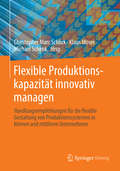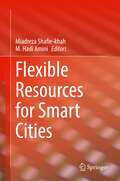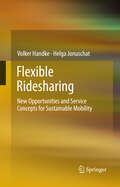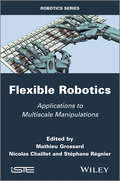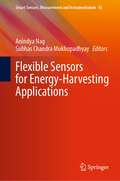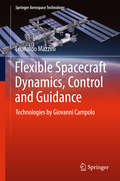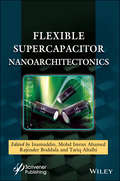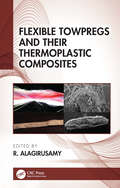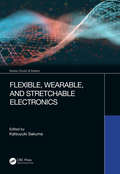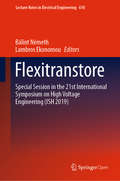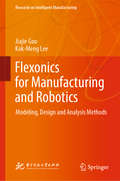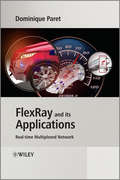- Table View
- List View
Flexible High Performance Magnetic Field Sensors: On-Scalp Magnetoencephalography and Other Applications
by Etienne Labyt Tilmann Sander Ronald WakaiThis contributed volume reviews the latest advances in all the new technologies currently developed for MagnetoEncephaloGraphy (MEG) recordings, as well as sensor technologies and integrated sensor arrays for on-scalp MEG. The book gives an account of the first MEG imaging studies and explores the new field of feasible, experimental paradigms of on-scalp MEG. This is an ideal book for engineers, researchers, and students in the neurosciences interested in MEG imaging.
Flexible Learning in a Digital World: Experiences and Expectations (Open and Flexible Learning Series)
by Collis, Betty Moonen, JefBetty Collis and Jef Moonen present a series of proven and practical guidelines, based on their balanced experience of using technology in education. Together, these give readers an overview of how technological applications in education can be developed and harnessed.
Flexible Load Control for Enhancing Renewable Power System Operation (Power Systems)
by Yuanzheng Li Yang Li Zhigang ZengThis book addresses the pressing challenges faced by renewable power system operation (RPSO) due to the increasing penetration of renewable energy and flexible load. These challenges can be divided into two categories. Firstly, the inherent uncertainties associated with renewable energy sources pose significant difficulties in RPSO. Secondly, the presence of various types of flexible load, along with their complex constraint relationships, adds to the operational complexities. Recognizing the growing emphasis on the economic and low-carbon aspects of RPSO, this book focuses on the key issues of flexible load control. It mainly consists of following categories: (1) The control of data centers, a booming flexible load, to enhance RPSO through renewable energy integration and advanced robust multi-objective optimization. (2) The introduction of flexible industrial load control, employing effective demand-supply cooperative responding strategies for RPSO. (3) The exploration of electricvehicle flexible charging load control and centralized electric vehicle charging system control in the context of RPSO. The book also covers the emerging field of flexible integrated load control for renewable energy-based comprehensive energy system operation. Aimed at researchers, engineers, and graduate students in electrical engineering and computer science, this book provides a valuable resource for understanding and implementing flexible load control in the context of RPSO.
Flexible Manufacturing Systems in Practice: Design: Analysis and Simulation
by Joseph TalavageThis book has been written for all those interested in flexible manufacturing systems (FMS) and other forms of computerized manufacturing systems (CMS). It deals with many aspects of the design, operation, and simulation of FMS and explains the origins of FMS.
Flexible Metal Forming Technologies: Principles, Process and Equipment (Springer Tracts in Mechanical Engineering)
by Xunzhong GuoThis book systematically introduces the principles of flexible forming technologies to manufacture thin-walled complex-shaped components, the mechanism of controlling the material flow, the design and the configuration of flexible forming technologies’ equipment and tools. It covers new technologies and new processes for forming hollow components, and relevant research on forming mechanisms, deformation laws, and defect control with examples from practical applications. It will be a useful reference for researchers, engineers, graduate and undergraduate students in aerospace, nuclear, railway, vehicle and petrochemical engineering, etc.
A Flexible Multi-Functional Touch Panel for Multi-Dimensional Sensing in Interactive Displays (Elements in Flexible and Large-Area Electronics)
by Shuo Gao Arokia NathanTouch screen panels (TSPs) have become an integral part of modern-day lifestyle. To enhance user experience, attributes such as form-factor flexibility, multi-dimensional sensing, low power consumption and low cost have become highly desirable. This Element addresses the design of multi-functional TSPs with integrated concurrent capture of ubiquitous capacitive touch signals and force information. It compares and contrasts interactive technologies and presents design considerations for multi-dimensional touch screens with high detection sensitivity, accuracy and resolution.
Flexible Multibody Dynamics: Efficient Formulations with Applications
by Arun BanerjeeThis book demonstrates how to formulate the equations of mechanical systems. Providing methods of analysis of complex mechanical systems, the book has a clear focus on efficiency, equipping the reader with knowledge of algorithms that provide accurate results in reduced simulation time. The book uses Kane’s method due to its efficiency, and the simple resulting equations it produces in comparison to other methods and extends it with algorithms such as order-n. Kane’s method compensates for the errors of premature linearization, which are often inherent within vibrations modes found in a great deal of public domain software. Describing how to build mathematical models of multibody systems with elastic components, the book applies this to systems such as construction cranes, trailers, helicopters, spacecraft, tethered satellites, and underwater vehicles. It also looks at topics such as vibration, rocket dynamics, simulation of beams, deflection, and matrix formulation. Flexible Multibody Dynamics will be of interest to students in mechanical engineering, aerospace engineering, applied mechanics and dynamics. It will also be of interest to industry professionals in aerospace engineering, mechanical engineering and construction engineering.
Flexible Multibody Dynamics: Efficient Formulations and Applications
by Arun K. BanerjeeArun K. Banerjee is one of the foremost experts in the world on the subject of flexible multibody dynamics. This book describes how to build mathermatical models of multibody systems with elastic components. Examples of such systems include the human body itself, construction cranes, cares with trailers, helicopers, spacecraft deploying antennas, tethered satellites, and underwater maneuvering vehicles. This book provides methods of analysis of complex mechanical systems that can be simulated in less computer time than other methods. It equips the reader with knowledge of algorithms that provide accurate results in reduced simulation time.
Flexible Multibody System Dynamics: Theory And Applications
by Mingjun XieThis volume examines the theoretical and practical needs on the subject of multibody system dynamics with emphasis on flexible systems and engineering applications. lt focuses on developing an all purpose algorithm for the dynamic simulation of flexible tree-like systems making use of matrix representation at all levels. The book covers new theories with engineering applications involved in broad fields which include; civil engineering, aerospace and robotics, as well as general and mechanical engineering. The applications include high temperature conditions, time variant contact conditions, biosystem analysis, vibration minimization and control.
Flexible OLEDs: Fundamental and Novel Practical Technologies (SpringerBriefs in Applied Sciences and Technology)
by Mitsuhiro KodenThis book offers a wealth of knowledge and information about the fundamental and practical aspects of flexible organic light-emitting diode (OLED) devices. The book provides an overview of these devices by considering their merits and business potential, the history of their research and development, the fundamental technology, and required properties for materials, devices, processes, and future trends of flexible OLED devices. The practical sections describe novel, cutting-edge expertise for flexible substrates, gas barriers, encapsulation, novel electrodes, and on-demand patterning for OLED devices. Applications of the technologies of ultra-thin glass, stainless steel foil, and barrier films are described as flexible substrates. The book also explains features such as dry-barrier layers, wet-barrier layers, multi-layer barrier structures, dam-fill encapsulation, thin film encapsulation (TFE), and laminating encapsulation. In addition, there are explanations of novel electrodes and on-demand ink-jet patterning, both of which are applicable to flexible OLED devices. As the novel electrodes, transparent conducting polymer, silver nanowire (AgNW), metal-mesh and roll-to-roll (R2R) process technologies are included. The know-how that is described here is applicable to flexible devices, not only for OLEDs, OPVs, OTFTs, and others but also for sensors, wearable devices, robots, and healthcare devices. The information contained in this valuable book is useful for all scientists, engineers, and managers who are interested in the field of flexible devices.
Flexible Packaging Of Foods (CRC Press Revivals)
by Aaron BrodyThis review encompasses one segment of food packaging – foods. That include flexible materials in their package. It is intended as a systems view point: designing product requirements and markets, and describing the present material and machine methods for filling those requirements.
Flexible Pedagogy, Flexible Practice: Notes from the Trenches of Distance Education
by Elizabeth Burge Chère Campbell Gibson Terry GibsonFlexibility has become a watchword in modern education, but its implementation is by no means a straightforward matter. Flexible Pedagogy, Flexible Practice sheds light on the often taken-for-granted assumptions that inform daily practice and examines the institutional dynamics that help and hinder efforts toward flexibility. The collection in international in scope, drawing on the experience of specialists in distance education from North America, the United Kingdom, Australia and New Zealand, South Africa, Singapore, and Japan. Contributors to the volume were asked to reflect candidly and critically on a series of questions, including: What precisely is flexible learning? Who or what is driving the flexibility agenda, and for whose benefit? And who or what is resisting it? What challenges must be overcome in order to achieve flexibility, and what are some of the compromises it can entail?
Flexible Piezoelectric Energy Harvesters and Sensors
by Bin Yang Zhiran Yi Chengkuo LeeFlexible Piezoelectric Energy Harvesters and Sensors A systematic and complete discussion of the latest progress in flexible piezoelectric energy harvesting and sensing technologies In Flexible Piezoelectric Energy Harvesters and Sensors, a team of distinguished researchers delivers a comprehensive exploration of the design methods, working mechanisms, microfabrication processes, and applications of flexible energy harvesters for wearable and implantable devices. The book discusses the monitoring of normal force, shear force, strain, and displacement in flexible sensors, as well as relevant artificial intelligence algorithms. Readers will also find an overview of design and research challenges facing professionals in the field, as well as a variety of perspectives on flexible energy harvesters and sensors. With an extensive focus on the use of flexible piezoelectric material technologies for medical applications, Flexible Piezoelectric Energy Harvesters and Sensors also includes: A thorough introduction to the working principles of piezoelectric devices, including discussions of flexible PEH and piezoelectric sensors Comprehensive treatments of the design of flexible piezoelectric energy harvesters, including the challenges associated with their structural design Fulsome explanations of the fabrication of flexible piezoelectric energy harvesters, including piezoelectric ceramic thin and think films In-depth treatments of cantilever piezoelectric energy harvesters, including optimized cantilever, bimorph, and optimized bimorph PEH Perfect for materials scientists, electronics engineers, and solid-state physicists, Flexible Piezoelectric Energy Harvesters and Sensors will also earn a place in the libraries of sensor developers, and surface physicists.
Flexible Produktionskapazität innovativ managen: Handlungsempfehlungen für die flexible Gestaltung von Produktionssystemen in kleinen und mittleren Unternehmen
by Christopher Marc Schlick, Klaus Moser and Michael SchenkDer flexible Einsatz von Mitarbeitern/-innen in produzierenden Unternehmen adressiert ein Thema von hoher wirtschaftlicher Bedeutung und Aktualität. Gestaltungsmöglichkeiten werden im Hinblick auf Produktionssysteme wie auch in Bezug auf den Einsatz der Personalressourcen behandelt. Produktionsplaner und Personalleitung erhalten konkrete Handlungsempfehlungen.Dieser praxisorientierte Handlungsleitfaden spricht insbesondere kleine und mittelständische Unternehmen an. "FlexPro - Flexible Produktionskapazität innovativ managen" war ein Forschungsprojekt in Unternehmen, dessen Ergebnisse als Grundlage dieses Leitfadens anschaulich erläutert werden.
Flexible Resources for Smart Cities
by Miadreza Shafie-Khah M. Hadi AminiThis book paves the road for researchers from various areas of engineering working in the realm of smart cities to discuss the intersections in these areas when it comes to infrastructure and its flexibility. The authors lay out models, algorithms and frameworks related to the ‘smartness’ in the future smart cities. In particular, manufacturing firms, electric generation, transmission and distribution utilities, hardware and software computer companies, automation and control manufacturing firms, and other industries will be able to use this book to enhance their energy operations, improve their comfort and privacy, as well as to increase the benefit from the electrical system. The book pertains to researchers, professionals, and R&D in an array of industries.
Flexible Ridesharing
by Volker Handke Helga JonuschatIndividual mobility is one of the most important needs of modern society and an important link between private, public and economic life. In contrast, transport also entails severe environmental and social burdens, foiling current efforts for sustainable development. As the main source of CO2 emissions, transport is a prominent driver for climate change, and individual car traffic is responsible for nearly a third of the total energy consumption. However, we have to consider that many commuters feel indeed very dependent on their car. Here, ridesharing promises to contribute to environmental protection, while still offering individual mobility. Although ridesharing options have been discussed since many years, internet and smartphones provide completeley new opportunities to find ridesharing partners today. Thus, this book deals with current efforts on implementing flexible internet- and phone-based ridesharing services. With a main focus on the users' perspective, their demands and acceptance limits, we aim to explore success factors for non-profit, but also commercial ridesharing concepts.
Flexible Robotics: Applications to Multiscale Manipulations (Wiley-iste Ser.)
by Mathieu Grossard Nicolas Chaillet Stéphane RégnierThe objective of this book is to provide those interested in the field of flexible robotics with an overview of several scientific and technological advances in the practical field of robotic manipulation. The different chapters examine various stages that involve a number of robotic devices, particularly those designed for manipulation tasks characterized by mechanical flexibility. Chapter 1 deals with the general context surrounding the design of functionally integrated microgripping systems. Chapter 2 focuses on the dual notations of modal commandability and observability, which play a significant role in the control authority of vibratory modes that are significant for control issues. Chapter 3 presents different modeling tools that allow the simultaneous use of energy and system structuring notations. Chapter 4 discusses two sensorless methods that could be used for manipulation in confined or congested environments. Chapter 5 analyzes several appropriate approaches for responding to the specific needs required by versatile prehension tasks and dexterous manipulation. After a classification of compliant tactile sensors focusing on dexterous manipulation, Chapter 6 discusses the development of a complying triaxial force sensor based on piezoresistive technology. Chapter 7 deals with the constraints imposed by submicrometric precision in robotic manipulation. Chapter 8 presents the essential stages of the modeling, identification and analysis of control laws in the context of serial manipulator robots with flexible articulations. Chapter 9 provides an overview of models for deformable body manipulators. Finally, Chapter 10 presents a set of contributions that have been made with regard to the development of methodologies for identification and control of flexible manipulators based on experimental data. Contents 1. Design of Integrated Flexible Structures for Micromanipulation, Mathieu Grossard, Mehdi Boukallel, Stéphane Régnier and Nicolas Chaillet. 2. Flexible Structures’ Representation and Notable Properties in Control, Mathieu Grossard, Arnaud Hubert, Stéphane Régnier and Nicolas Chaillet. 3. Structured Energy Approach for the Modeling of Flexible Structures, Nandish R. Calchand, Arnaud Hubert, Yann Le Gorrec and Hector Ramirez Estay. 4. Open-Loop Control Approaches to Compliant Micromanipulators, Yassine Haddab, Vincent Chalvet and Micky Rakotondrabe. 5. Mechanical Flexibility and the Design of Versatile and Dexterous Grippers, Javier Martin Amezaga and Mathieu Grossard. 6. Flexible Tactile Sensors for Multidigital Dexterous In-hand Manipulation, Mehdi Boukallel, Hanna Yousef, Christelle Godin and Caroline Coutier. 7. Flexures for High-Precision Manipulation Robots, Reymond Clavel, Simon Henein and Murielle Richard. 8. Modeling and Motion Control of Serial Robots with Flexible Joints, Maria Makarov and Mathieu Grossard. 9. Dynamic Modeling of Deformable Manipulators, Frédéric Boyer and Ayman Belkhiri. 10. Robust Control of Robotic Manipulators with Structural Flexibilities, Houssem Halalchi, Loïc Cuvillon, Guillaume Mercère and Edouard Laroche. About the Authors Mathieu Grossard, CEA LIST, Gif-sur-Yvette, France. Nicolas Chaillet, FEMTO-ST, Besançon, France. Stéphane Régnier, ISIR, UPMC, Paris, France.
Flexible Sensors for Energy-Harvesting Applications (Smart Sensors, Measurement and Instrumentation #42)
by Anindya Nag Subhas Chandra MukhopadhyayThis book investigates the fabrication of different types of flexible sensors and their subsequent implementation for energy-harvesting applications. A range of techniques, including 3D printing, soft lithography, laser ablation, micro-contract printing, screen-printing, inkjet printing and others have been used to form the flexible sensors with varied characteristics. These sensors have been used for biomedical, environmental and healthcare applications on the basis of their performances. The quality of these flexible sensors has depended on certain types of nanomaterials that have been used to synthesize the conductive parts of the prototypes. These nanomaterials have been based on different sizes and shapes, whose quality varied on the basis of certain factors like crystallinity, shapes and sizes. One of the primary utilization of these nanotechnology-based flexible sensors has been the harvesting of energy where nano-generators and nano-harvesters have been formed to generate and store energy, respectively, on small and moderate magnitudes. Mechanical and thermal energies have been harvested on the basis of the piezoelectric, pyroelectric and triboelectric effects created by the formed prototypes. The work highlights the amalgamation of these sectors to spotlight the essence of these types of sensors and their intended application.
Flexible Spacecraft Dynamics, Control and Guidance
by Leonardo MazziniThis book is an up-to-date compendium on spacecraft attitude and orbit control (AOC) that offers a systematic and complete treatment of the subject with the aim of imparting the theoretical and practical knowledge that is required by designers, engineers, and researchers. After an introduction on the kinematics of the flexible and agile space vehicles, the modern architecture and functions of an AOC system are described and the main AOC modes reviewed with possible design solutions and examples. The dynamics of the flexible body in space are then considered using an original Lagrangian approach suitable for the control applications of large space flexible structures. Subsequent chapters address optimal control theory, attitude control methods, and orbit control applications, including the optimal orbital transfer with finite and infinite thrust. The theory is integrated with a description of current propulsion systems, with the focus especially on the new electric propulsion systems and state of the art sensors and actuators.
Flexible Supercapacitor Nanoarchitectonics
by Inamuddin Mohd Imran Ahamed Rajender Boddula Tariq AltalhiThe 21 chapters in this book presents a comprehensive overview of flexible supercapacitors using engineering nanoarchitectures mediated by functional nanomaterials and polymers as electrodes, electrolytes, and separators, etc. for advanced energy applications. The various aspects of flexible supercapacitors, including capacitor electrochemistry, evaluating parameters, operating conditions, characterization techniques, different types of electrodes, electrolytes, and flexible substrates are covered. This is probably the first book of its type which systematically describes the recent developments and progress in flexible supercapacitor technology, and will be very helpful for generating new and innovative ideas in the field of energy storage material for wearable/flexible industry applications.
Flexible Towpregs and Their Thermoplastic Composites
by R. AlagirusamyThermoplastic matrix composites have attracted much attention in the composites industry due to their easy processibility and improved impact properties. Although there are many books on thermoplastic composites available, none emphasize flexible towpregs and their composite properties. This book discusses various methods of manufacturing flexible towpregs, their properties, their textile preforming behavior, the properties of textile preform, and the properties of final composites. FEATURES Gives readers a complete view of composite manufacturing Offers details on flexible prepregs that other books overlook, such as manufacturing methods, influence of processing parameters, and properties Includes explanations that cover all steps of manufacturing with examples Features case studies and homework exercises for all chapters to reinforce understanding Provides technological information, discussion, and analysis of problems related to all types of flexible towpregs, such as commingling, electrostatic powder coating, wrapped hybrid yarns, micro-braided hybrid yarns, core-spun hybrid yarns, and others This book is aimed at readers working with composite materials, industrial textiles, and related areas to understand the significance of thermoplastic composites made through textile performance of flexible towpregs.
Flexible, Wearable, and Stretchable Electronics (Devices, Circuits, and Systems)
by Katsuyuki Sakuma Krzystof IniewskiRemarkable progress has been achieved within recent years in developing flexible, wearable, and stretchable (FWS) electronics. These electronics will play an increasingly significant role in the future of electronics and will open new product paradigms that conventional semiconductors are not capable of. This is because flexible electronics will allow us to build flexible circuits and devices on a substrate that can be bent, stretched, or folded without losing functionality. This revolutionary change will impact how we interact with the world around us. Future electronic devices will use flexible electronics as part of ambient intelligence and ubiquitous computing for many different applications such as consumer electronics, medical, healthcare, and security devices. Thus, these devices have the potential to create a huge market all over the world. Flexible, Wearable, and Stretchable Electronics, provide a comprehensive technological review of the state-of-the-art developments in FWS electronics. This book offers the reader a taste of what is possible with FWS electronics and describes how these electronics can provide unique solutions for a wide variety of applications. Furthermore, the book introduces and explains new applications of flexible technology that has opened up the future of FWS electronics.
Flexitranstore: Special Session in the 21st International Symposium on High Voltage Engineering (ISH 2019) (Lecture Notes in Electrical Engineering #610)
by Lambros Ekonomou Bálint NémethThis open access book comprises 10 high-level papers on research and innovation within the Flexitranstore Project that were presented at the FLEXITRANSTORE special session organized as part of the 21st International Symposium on High Voltage Engineering.FLEXITRANSTORE (An Integrated Platform for Increased FLEXIbility in smart TRANSmission grids with STORage Entities and large penetration of Renewable Energy Sources) aims to contribute to the development of a pan-European transmission network with high flexibility and high interconnection levels. This will facilitate the transformation of the current energy production mix by hosting an increasing share of renewable energy sources. Novel smart grid technologies, control and storage methods, and new market approaches will be developed, installed, demonstrated, and tested introducing flexibility to the European power system.FLEXITRANSTORE is developing a next-generation Flexible Energy Grid (FEG) that will be integrated into the European Internal Energy Market (IEM) through the valorization of flexibility services. This FEG addresses the capabilities of a power system to maintain continuous service in the face of rapid and large swings in supply or demand. As such, a wholesale market infrastructure and new business models within this integrated FEG must be upgraded for network players, and offer incentives for new ones to join, while at the same time demonstrating new business perspectives for cross-border resource management and energy trading.
Flexonics for Manufacturing and Robotics: Modeling, Design And Analysis Methods (Research on Intelligent Manufacturing)
by Jiajie Guo Kok-Meng LeeThis book presents the theoretical research and application results of a study on flexible mechatronics (flexonics). Formulating distributed models in both time and spatial domains using a geometric approach, it presents a simple yet practical field-based sensing method for robotics and manufacturing, and illustrates its applications with examples such as exoskeletons, mobile sensor network and intelligent sensing.The book is of interest to researchers, engineers and graduate students in robotics, manufacturing and automation engineering who wish to learn the core principles, theories, technologies, and applications of flexonics.
FlexRay and its Applications: Real Time Multiplexed Network
by Dominique ParetAn authoritative yet highly accessible guide to the design and operation of the FlexRay bus, the latest protocol for automotive network communications A translation of the French edition, originally published in January 2011, this work is the result of numerous training courses that Dominique Paret has given in companies, and it provides detailed explanations of the design and operation of the FlexRay bus. Comprised of five parts the book covers: the FlexRay concept and its communication protocol; the FlexRay physical layer; synchronization and global time and; architecture of a node, components and development aid tools for hardware and software. Provides comprehensive treatment of the FlexRay network, including its implementation through a real automotive application Includes the latest specifications (Version 3) concluded by the FlexRay consortium widely expected to become the industry standard Written by an author with in-depth experience of automotive electronics, including FlexRay, and presenter of specialist training courses to the industry Includes a review of industrial tools to help design and implement a FlexRay based distributor application
